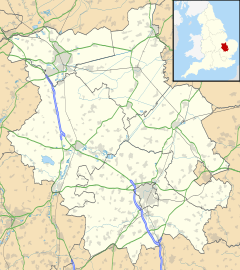Castor, Cambridgeshire facts for kids
Quick facts for kids Castor |
|
|---|---|
| Population | 817 (2001 census) |
| OS grid reference | TL124985 |
| Civil parish |
|
| Unitary authority |
|
| Ceremonial county | |
| Region | |
| Country | England |
| Sovereign state | United Kingdom |
| Post town | Peterborough |
| Postcode district | PE5 |
| Dialling code | 01733 |
| Police | Cambridgeshire |
| Fire | Cambridgeshire |
| Ambulance | East of England |
| EU Parliament | East of England |
| UK Parliament |
|
| Website | Castor Home Page |
Castor is a small village and civil parish located in the City of Peterborough, England. It's about 4 kilometers (2.5 miles) west of the city center. For a long time, Castor was considered part of Northamptonshire, then Huntingdon and Peterborough, before finally becoming part of Cambridgeshire in 1974. It's a place with a very long and interesting history, especially from Roman times.
Contents
What's in a Name? The Story of Castor
The name Castor comes from an old English word, "ceaster." This word often referred to a Roman fort or camp. It might have been named after a Roman fort called Durobrivae across the River Nene. However, it's more likely that the name refers to a huge Roman building on a hilltop in Castor itself.
A Look Back: Castor's History
Castor has a rich history, stretching back thousands of years.
Roman Times: A Grand Palace
During the Roman period, Castor was home to a massive, palace-like building. This structure was explored in the 1820s by Edmund Artis. He thought it might have been a Praetorium, which was a large Roman official building.
- Huge Size: Recent studies show this Roman building was enormous. It covered an area of about 290 by 130 meters (about 3.77 hectares).
- Fancy Rooms: It had at least 11 rooms with beautiful tiled floors and mosaics. There were also at least two bathhouses and special heating systems called hypocausts.
- Important Purpose: Experts believe the building was first built in the 2nd century. A larger, more grand palace was added between 240 and 260 AD. It's thought that this building was a center for collecting taxes from a large Roman imperial estate in the Fens area.
- Pottery Powerhouse: The Castor area was also a major center for making pottery. The Nene valley pottery industry was one of the biggest in late Roman Britain. They made pottery on a very large scale.
- End of an Era: The Roman palace seems to have been left empty in the 5th century.
Early Medieval Period: A Saint's Story
After the Romans left, Castor became important again in the late 7th and 8th centuries.
- Saint Kyneburgha: It's believed that a nunnery (a place where nuns live) was founded here by Saint Kyneburgha. She was a princess, the daughter of King Penda of Mercia.
- Abbey Life: Kyneburgha married Alhfrith of Deira, a co-ruler of Northumbria. But she later started an abbey in Castor for both monks and nuns. She became the first abbess (the head of the abbey).
- Her Legacy: Saint Kyneburgha was buried in her church. Her remains were later moved to Peterborough Abbey, which is now Peterborough Cathedral. She was also one of the people who signed the founding document for Peterborough Abbey in 664.
- Viking Raids: Sadly, the Danes (Vikings) attacked and destroyed the area around 870 AD.
The Church of England parish church of St Kyneburgha is still standing today.
- Amazing Architecture: It's famous for its Romanesque architecture (a style of building from the Middle Ages). It also has some notable medieval wall paintings.
- Unique Church: It's the only church in England named after Saint Kyneburgha.
- Tall Tower: The Romanesque tower is 22 meters (71 feet) high. A spire was added later, making the total height 35 meters (115 feet).
Late Medieval Period: Standing Stones
- Robin Hood and Little John Stones: Between the 12th and 14th centuries, two large stones were put up in Castor. They are called the Robin Hood and Little John Standing Stones.
- Toll Agreement: These stones were part of an agreement with the abbot of Peterborough Abbey. They meant that no tolls (fees) would be charged for moving stone from the abbey's quarries in Barnack.
Modern Times: Changes and Discoveries
- Land Use: The common lands of Castor and the nearby village of Ailsworth were not divided up until 1898.
- Railway History: A railway line used to pass through Castor. It opened in 1845, and Castor railway station was built for the village. The station closed in 1957, and the line closed in 1966.
- Nene Valley Railway: The Nene Valley Railway reopened part of the line through Castor in 1977. However, a station has not been reopened in Castor.
- New Road: A new bypass for Ailsworth and Castor, part of the A47 road, opened in 1991.
- TV Show: In 2011, an episode of the TV show Time Team was filmed in Castor. The show helped to reveal and confirm just how huge the Roman praetorium really was!
See also
 In Spanish: Castor (Cambridgeshire) para niños
In Spanish: Castor (Cambridgeshire) para niños



